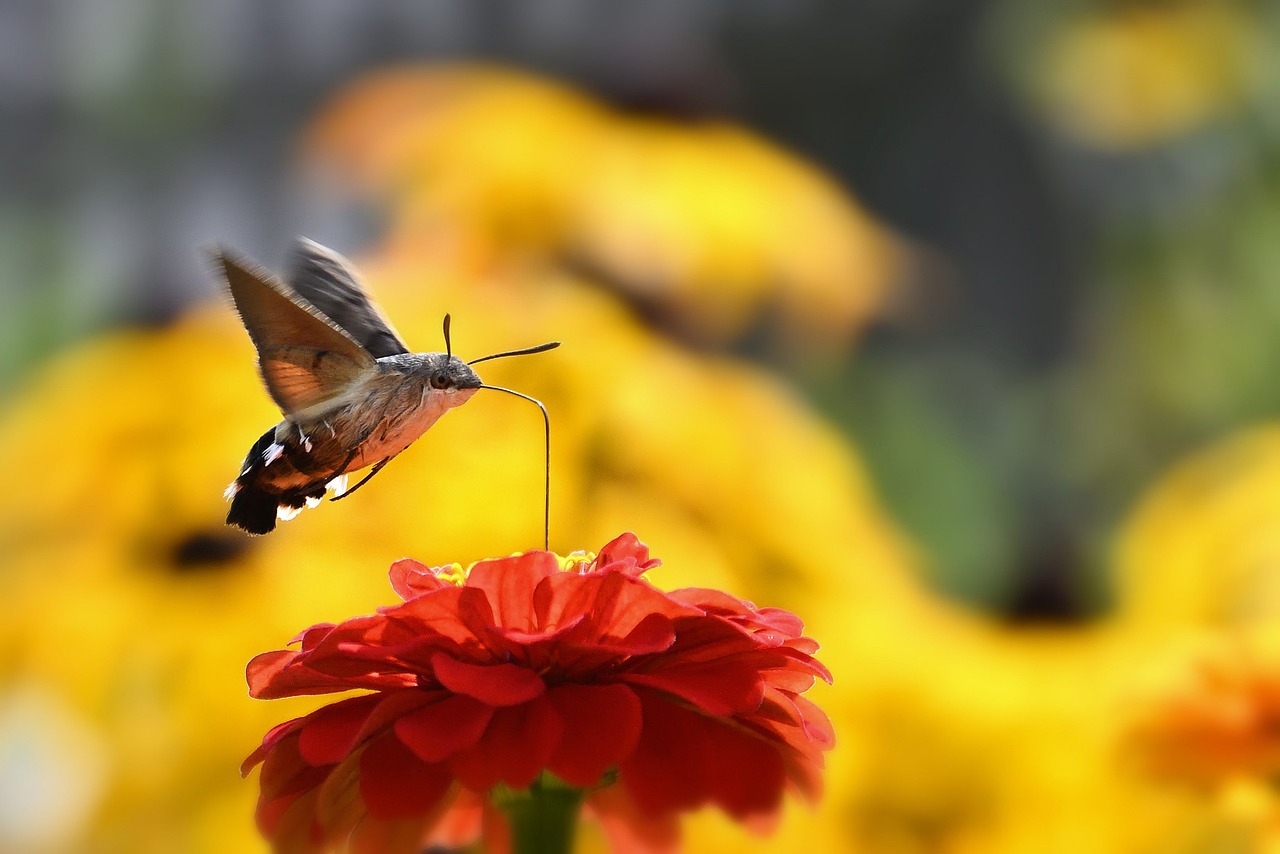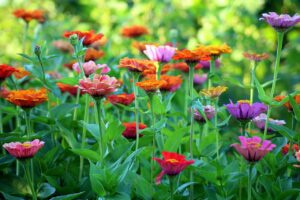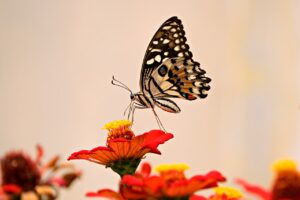Zinnia
Overview
Zinnias are vibrant, easy-to-care-for plants that brighten gardens with a kaleidoscope of colors. As members of the Asteraceae family, they’re prized for their daisy-like blooms and ability to attract butterflies. Thriving in hot climates, zinnias are fast-growing annuals that make excellent additions to flower beds and are perfect as cut flowers.

Characteristics
Known for their bright and diverse colors, ease of cultivation, and attractiveness to butterflies.
Region
Zinnias are usually grown in USDA hardiness zones 2-11 as annuals.
Natural Habitat
Zinnias are commonly found in the wild in grasslands and scrublands.
Cultivation
Full sun exposure, moderate watering avoiding wet foliage, and well-drained soil with a neutral to slightly alkaline pH.
Uses and Benefits
Zinnias bring a burst of exuberance to any outdoor space; their bright, enchanting colors can lift spirits and transform a drab garden into a festival of hues. These hardy flowers aren’t just a visual feast—they’re also a haven for butterflies, providing a source of food and a place for these beautiful insects to flourish2. The joy of zinnias extends beyond the garden; their robust stems make them ideal for cutting and bringing indoors, ensuring that the same vibrancy that adorns your garden can also enhance your living space1.
Zinnias offer a wealth of benefits for both the garden and the home:
- Attracting pollinators: Zinnias are a magnet for butterflies, bees, and hummingbirds, making them essential for maintaining a thriving ecosystem in your garden.
- Long-lasting cut flowers: With their sturdy stems and vibrant colors, zinnias make excellent cut flowers that can last up to two weeks in a vase, bringing a touch of the garden’s beauty into your home.
- Easy to grow: Zinnias are low-maintenance and can thrive in various soil types, making them an ideal choice for novice gardeners or those with limited time for gardening.
- Continuous blooms: From summer to early fall, zinnias provide a constant display of color, ensuring that your garden remains vibrant throughout the growing season.
Whether gracing your garden beds or your dining room table, zinnias are a true embodiment of joy, proving that sometimes the simplest pleasures, like a single stem of brightly colored petals, can be the most rewarding.

Cultivation Tips
Zinnia cultivation can be delightfully straightforward. After the threat of frost has passed, you can sow seeds directly into your garden space, making sure they have a cozy depth of about a quarter-inch3. Space is also key—aim for 6 to 12 inches apart so that each zinnia has room to breathe and bask in the sunshine3.
To ensure your zinnias thrive:
- Choose a spot with full sun exposure and well-draining soil
- Water regularly, keeping the soil moist but not soggy
- Deadhead spent blooms to encourage continuous flowering
- Protect young seedlings from slugs and snails
This vibrant flower is not just a feast for our eyes but also attracts butterflies, adding a flutter of life to your garden2. If you’re a fan of having fresh blossoms indoors, zinnias make fantastic cut flowers, so feel free to snip a few for a splash of color inside your home2.
Pro tip: For longer-lasting cut flowers, harvest zinnias when the blooms are just starting to open, and place them in a vase with fresh water and flower food.
Remember, these beauties crave the heat, so they’ll soak up the summer sun and give your garden a brilliant display of hues1. Keep it simple, and these plants will reward you generously!
Seasonal Considerations
Zinnia cultivation can be a delightful and straightforward adventure for any gardener. Once the threat of frost has passed, you can sow zinnia seeds directly into your garden bed. Aim to plant the seeds at a cozy depth of about a quarter-inch, ensuring they have just the right amount of soil to germinate and thrive3.
When it comes to spacing, zinnias appreciate room to breathe and bask in the sunshine. For optimal growth, consider the following spacing guidelines:
- Space seeds or seedlings 6 to 12 inches apart
- Allow enough room between rows for easy access and maintenance
- Proper spacing promotes good air circulation and reduces risk of disease
Not only do zinnias add a vibrant splash of color to your garden, but they also attract beautiful butterflies, bringing an extra flutter of life to your outdoor space2. If you enjoy having fresh blossoms indoors, zinnias make fantastic cut flowers. Feel free to snip a few stems for a gorgeous bouquet that will brighten up any room in your home2.
One of the best things about zinnias is their love for the summer heat. They thrive in warm, sunny conditions and will reward you with a brilliant display of colors throughout the season1. By keeping your zinnia care simple and providing them with the basic necessities, you’ll be able to enjoy a stunning and low-maintenance garden that will be the envy of your neighborhood!

Issues and Troubleshooting
While zinnias are generally resilient plants, they can occasionally face some challenges. If your zinnias seem to be struggling, it could be due to a few common issues:
- Powdery mildew: This fungal disease may appear if the leaves remain damp and don’t receive enough sunlight or air circulation. To combat this, ensure your plants have plenty of space to breathe and, when watering, focus on the soil rather than the foliage.
- Insect infestations: Pests like aphids or spider mites might take a liking to your zinnias. Watch for signs of these tiny creatures and their damage, which often appears as a sticky residue or fine webs on your flowers. A thorough spray with water or insecticidal soap should help eliminate them.
- Inadequate growing conditions: If your zinnias appear stunted, they may not be getting enough sunshine or the soil could be deficient in nutrients. Ensure your plants receive full sun exposure and consider adding a little fertilizer to help them perk up.
Remember, happy zinnias are well-fed and sunbathed zinnias1. By addressing these common issues, you can help your zinnias thrive and enjoy their vibrant blooms throughout the growing season.
History and Folklore
The zinnia, now a garden favorite with its kaleidoscope of vivid hues, has roots tracing back to ancient traditions. Engraved in the chronicles of history and folklore, the zinnia was once deeply entwined with superstitious beliefs.
In the language of flowers—a Victorian-era code used to express sentiments—an offering of zinnias spoke of thoughts of absent friends. These striking flowers, originating in the scrubby lands of Mexico, made their way into the gardens and hearts of people around the world.
Their name commemorates the German botanist Johann Gottfried Zinn, though their story is interlaced with tales that traverse beyond the boundaries of botany, coloring the cultural canvas with vibrant strokes of myth and lore.
As the zinnia charmed its way across continents, it became a symbolic token of remembrance, a flourishing reminder of connections undiminished by distance or time.
Whether nestled in a folk story or standing tall in your own garden, zinnias carry with them whispers of history and a spirit of enduring friendship.
References
1. “How to grow zinnias – plant, care and maintenance tips,” https://www.homesandgardens.com/advice/how-to-grow-zinnias
2. “Zinnias: How to Plant, Grow, and Care for Zinnia Flowers,” https://www.almanac.com/plant/zinnias
3. “How to Plant, Grow, and Care For Beautiful Zinnia Flowers,” https://www.epicgardening.com/zinnia/
4. “Zinnia: How to Grow and Care with Success,” https://www.gardenia.net/guide/zinnia-plant-care-and-growing-guide
5. “How to Plant and Care for Zinnia Flowers,” https://www.thespruce.com/zinnias-a-burst-of-hot-flower-colors-from-zinnias-1402919
Image Credit: jggrz
Image Credit: _Alicja_
Image Credit: ignartonosbg
Nicolas Duval
Nicolas is a passionate advocate for nature and the art of wildcrafting. His dedication shines through in Wildcraftia, a website he meticulously crafted to serve as a haven for nature enthusiasts worldwide. Driven by a deep appreciation for nature’s connection to humanity, Nicolas embarked on his journey in 2011 with SmokableHerbs, a platform showcasing his love for nature’s bounty. Building upon this foundation, he established Smokably, a thriving online store offering premium herbs and blends to a global audience.
